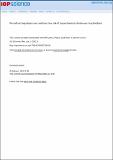Permafrost degradation and methane: low risk of biogeochemical climate-warming feedback
Author(s)
Gao, Xiang; Anthony, Katey Walter; Zhuang, Qianlai; Kicklighter, David; Schlosser, Adam; Sokolov, Andrei P.; ... Show more Show less
DownloadGao-2013-Permafrost degradati.pdf (1.036Mb)
PUBLISHER_CC
Publisher with Creative Commons License
Creative Commons Attribution
Terms of use
Metadata
Show full item recordAbstract
Climate change and permafrost thaw have been suggested to increase high latitude methane emissions that could potentially represent a strong feedback to the climate system. Using an integrated earth-system model framework, we examine the degradation of near-surface permafrost, temporal dynamics of inundation (lakes and wetlands) induced by hydro-climatic change, subsequent methane emission, and potential climate feedback. We find that increases in atmospheric CH[subscript 4] and its radiative forcing, which result from the thawed, inundated emission sources, are small, particularly when weighed against human emissions. The additional warming, across the range of climate policy and uncertainties in the climate-system response, would be no greater than 0.1 ° C by 2100. Further, for this temperature feedback to be doubled (to approximately 0.2 ° C) by 2100, at least a 25-fold increase in the methane emission that results from the estimated permafrost degradation would be required. Overall, this biogeochemical global climate-warming feedback is relatively small whether or not humans choose to constrain global emissions.
Date issued
2013-07Department
Massachusetts Institute of Technology. Center for Global Change Science; Massachusetts Institute of Technology. Joint Program on the Science & Policy of Global ChangeJournal
Environmental Research Letters
Publisher
IOP Publishing
Citation
Gao, Xiang, C Adam Schlosser, Andrei Sokolov, Katey Walter Anthony, Qianlai Zhuang, and David Kicklighter. “Permafrost degradation and methane: low risk of biogeochemical climate-warming feedback.” Environmental Research Letters 8, no. 3 (September 1, 2013): 035014.
Version: Final published version
ISSN
1748-9326